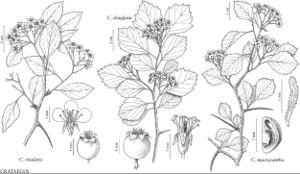Crataegus macracantha
Arbor. Frutic. Brit. 2: 819, figs. 572, 573. 1838.
Shrubs, 40–60(–80) dm. Stems: older trunks usually bearing compound thorns; twigs: new growth reddish green, usually glabrous, 1-year old dark, shiny reddish brown, 2–3-years old becoming dark gray, older ± paler gray; thorns on twigs usually numerous, recurved, shiny, dark blackish brown, older gray, stout, 3–7(–11) cm. Leaves: petiole 1–2 cm, narrowly winged distally, glabrous, eglandular, rarely glandular (on distal wing); blade narrowly rhombic-elliptic to broadly rhombic-ovate (sometimes narrowly obovate), 4–7(–10) cm widest near middle, subcoriaceous mature (then often blue-green), base cuneate (constricted into winged distal part of petioles), lobes 3–5 per side, sinuses obscure to well-marked, LII 5–15%, lobe apex usually obtuse, margins serrate except near bases, veins 6–8 per side, impressed, apex acute to obtuse, abaxial surface glabrous (except in var. pertomentosa), adaxial scabrous-pubescent young. Inflorescences 15–30-flowered; branches pubescent or glabrous; bracteoles ± pallid, linear, margins glandular, sometimes long-stipitate-glandular. Flowers 13–19 mm diam.; hypanthium glabrous or sparsely to densely pubescent; sepals narrowly triangular, 4–6 mm, margins glandular-serrate to glandular-laciniate, abaxial pubescence not recorded, adaxially glabrous; stamens 10, anthers white or pink, 0.9–1.2 mm; styles 2 or 3. Pomes: brilliant scarlet (west) to full crimson (east), suborbicular, 7–12 mm diam., succulent mature, glabrous or pubescent; sepals spreading-reflexed; pyrenes 2 or 3, sides pitted. 2n = 68.
Phenology: Flowering Apr–Jun; fruiting Sep–Oct.
Habitat: Brush
Elevation: 20–1600 m
Distribution

Alta., B.C., Man., N.B., Ont., Que., Sask., Ariz., Colo., Conn., Ill., Ind., Iowa, Kans., Md., Mass., Mich., Minn., Mo., Mont., Nebr., N.H., N.Mex., N.Y., N.Dak., Ohio, Oreg., Pa., R.I., S.Dak., Utah, Vt., Va., Wash., W.Va., Wis., Wyo.
Discussion
Crataegus macracantha is the most widespread North American hawthorn and one of the more variable. Variation is particularly great in Quebec and Montana. Attempts to package the variation into named taxa have hitherto run into the problems that the type is an illustration of inadequate quality and that authors have been insufficiently aware of the total variation. Two common eastern forms are similar white-anthered and pink-anthered with abaxially glabrous, broadly elliptic-ovate leaves, shallowly and sharply lobed, and fruit ripening directly from green to red; these have the longest thorns in the species, and both have been treated as if typical.
Crataegus occidentalis, a white-anthered, intermontane form with leaves similar to the foregoing usually has shorter thorns and fruit ripening to red through a characteristic orange or salmon stage. Pink-anthered C. pertomentosa, with leaves of a similar shape but abaxially pubescent to tomentose grows on the Great Plains. The last two forms have been treated as varieties. Other striking variants have brilliant red bracteoles or strongly convex leaves (both from Montana) and entire-margined sepals (C. integriloba Sargent from Quebec). Some rare forms have glabrous inflorescences. Some populations in northwestern Montana, otherwise much like a common pink-anthered sympatric form, have glandular petioles and may represent introgression from another species.
Crataegus macracantha often forms suckering thickets in the east.
Selected References
None.
